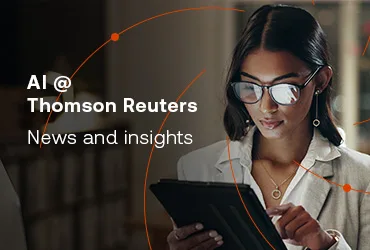Artificial Intelligence (AI) has exploded in the public mind over the last year, with many examples of AI-generated text, artwork and even full video. The talk of AI “replacing” entire industries is back at the front of the conversation – with lawyers and accountants often mentioned as vulnerable.
Artificial intelligence is not going to replace experienced professionals right now, but people who can use AI effectively will quickly outpace those who can’t. AI is changing how many people work – and it’s here to stay. Your clients will need your AI insights, and your organization may need your AI knowledge.
So, how do you make sure it doesn’t leave you behind?
You may find that you actually know more about AI than you thought you did – that you’ve been using AI, every day, for many years. This article will explain the most common AI terminology you need to know to engage in the AI conversation in your workplace.
What is artificial intelligence?
Artificial intelligence, or AI for short, is broadly defined as a branch of computer science that aims to develop intelligent machines, which can perform tasks that typically require human intelligence. This includes learning, problem-solving, decision making, etc. Examples of AI from everyday life range from maps and navigation to text editors and autocorrect to chatbots and digital assistants, like Siri.
What is an algorithm?
An algorithm is a set of rules to be followed in calculations or other problem-solving operations, especially by a computer. In a math equation, an algorithm is the method we use to solve long division problems. A search engine, like Google, uses algorithms to find the most relevant information for the searcher.
What is machine learning?
Machine learning (ML) is a subset of AI that can learn without following explicit instructions by inferring patterns in data using statistical models and algorithms. Examples of ML include social media feeds, product recommendations, and image recognition.
What is natural language processing?
Natural language processing (NLP) focuses on generating human language – both spoken and written – not robotic speech or restrictive text. Natural language processing applies algorithms to extract and analyze language data in a way that computers can process. It is imperative for machines to be able to process enormous amounts of data – to be able to mine it and organize it and ultimately, to translate it and output human-seeming content.
What is natural language search?
Natural language search (NLS) is a type of search method that allows users to interact with a computer system or search engine using everyday language instead of formalized search queries or specific commands. Natural language search means that when you’re searching for a new gym by searching for “gym,” your results will include most places that are focused on fitness, regardless of whether the name of the business actually includes the word “gym.” From a traditional gym, a CrossFit or yoga studio, Google understands that “gym” and “studio” in this instance have a similar meaning.
Your search inquiry doesn’t have to be all inclusive (gym and studio and fitness and yoga and CrossFit and health and club) to get all-inclusive results. You get to type like a human, not a robot. And with a little help from machine learning, it’s going to keep your results local.
As a professional, it also means that when you’re searching through research documents and briefs, you don’t always have to use exact-match language to find precisely what you’re looking for.
What is data mining?
Data mining is the process of looking for relationships, correlations, and patterns within large data sets. Technology systems scour data and recognize anomalies within the data at a scale that would be impossible for humans. This analysis helps predict outcomes, finds potential wrongdoings, and notices questionable trends, and that information derived can be useful in a variety of ways.
What you need to know about data mining
Your recommendations (hopefully) keep getting better. By analyzing the patterns of people who also buy or are interested in the same products as you, a store can make relevant suggestions based on that data. This same concept plays out in Netflix recommendations or targeted advertisements online.
What is the difference between structured and unstructured data?
To put it simply, structured data is organized data, defined within a particular structure. It may be referred to as quantitative data. It is objective and easy to export to and store in Microsoft Excel or a larger database. The way it is organized is consistent and easily identifiable, which makes data mining better. Structured data is also less complicated to analyze and distill.
On the other hand, unstructured data isn’t organized. It has no externally defined structure, and cannot be easily exported, stored, or organized. And it’s the bulk of what most organizations deal with daily. It includes most text-heavy data, such as reports, Microsoft Word documents, emails, and webpages.
What you need to know about structured and unstructured data
Structured data has made it easy for you to complete searches and inquiries for decades. And because the data is organized and objective, you can be sure that the results you are shown are the most accurate.
For example, transactional data from a sales report – e.g. Rep X sold Y units of product Z, for a total revenue this year of $$ –is structured data, and easily analyzed. But that same rep’s detailed listing of feedback from new users of the product during implementation is unstructured, and has traditionally been difficult to examine, analyze, and quantify.
Recent advances in AI, such as Large Language Models and Foundation Models, have largely been about using vast repositories of unstructured data in new ways. See the companion article on machine learning for more details.
What is big data?
Big data refers to the data sets that are too large or complex to be handled by traditional data-processing software. Big data is a combination of structured, semi-structured, and unstructured data. Examples of big data include customer databases, all the information posted on a social media site, or trade data from the New York Stock Exchange.
What does AI mean for your future?
Everything discussed above is generally well-understood and has been in use in many professional products for years – decades in some cases. Remember the first time you typed a plain-language search to find what you needed? That was a type of AI. You should be relatively comfortable with these AI concepts, since you’ve been using them for years in your daily life, probably without even realizing.
But AI is not standing still. The consumer versions of Large Language Models have been all over the news, specifically ChatGPT and other chatbots. These AI technologies have the potential to disrupt the work of all professionals – and you should be in the know. To stay on top of recent AI developments, visit our hub on artificial intelligence and read our companion article on generative AI and chat bots to learn more.









